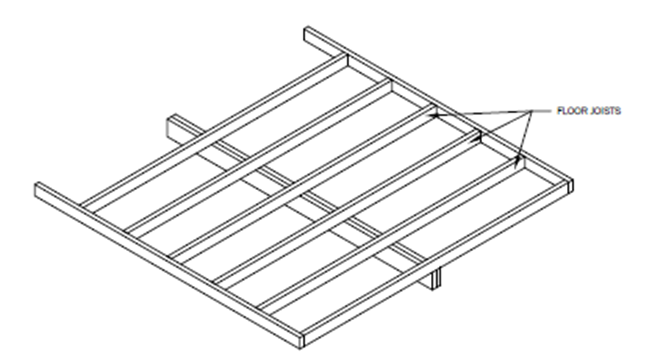Week 6: Flooring
Wood Floor Framing Systems:
- Light frame uses multiple small wood joints to carry a load
- Heavy timber frame relies on columns and beams to carry a load
- Structural steel floor framing system relies on regularly placed column that support steel beams. Girders span the beams and carry the metal decking. concrete is poured into the metal decking to create the floor system
- Open web steel joists are used to carry metal decking for a concrete metal decking floor system
- Concrete as a flooring system is either poured in place on site or cast at a plant and assembled on site
- Floor insulation must be installed to keep cold air from the ground from moving into the finished space above. Insulation is used when a floor is installed above a crawl space or above the earth
- Interior floor material
- multiple materials are used
- Use of the space and building code requirements narrow type of floor finishes to use
- this is divided into hard and soft surfaces.
- Hard surfaces
- concrete
- used as a subfloor
- can be used as a finished floor
- various textures and colors are available
- used in commercial and residential design
- brick
- brick or brick pavers may be used as finished flooring
- often seen in historical homes
- various patterns for laying brick such as basket weave, diagonal, and herringbone
- stone
- various types of stone can be used as flooring
- marble, granite, limestone, slate, travertine
- stone varies in composition and color
- stone is a natural material and there is a finite supply
- when sourcing stone we need to consider the origin
- terrazzo
- green building material
- cement or resin binder with marble or glass chips
- unique appearance and colors
- extremely hard and durable
- used in heavily trafficked areas such as lobbies
- ceramic tile
- Installed in thin set or thick set.
- Tile is always started in the center of the room
- The designer can create a variety of designs with ceramic tile
- Soft Surfaces
- Carpet
- Used in commercial and residential application
- contains two parts: the pile and backing
- excellent acoustical qualities
- carpeting made from natural fiber such as wool or synthetic, petroleum-based fibers, polyester, or nylon
- Wood
- Used in commercial and residential applications
- used for thousands of years as a floor finish
- flooring comes in strips, planks, or blocks
- various species including oak, walnut, cherry, maple, teak, and mahogany
- resilient flooring
- used in commercial and residential applications
- not sustainable product
- glued down or floating floor
- Linoleum
- Used extensively before vinyl flooring
- ingredients are environmentally safe
- ingredients include linseed oil, rosin limestone, and jute backing.
- Anti-micro bacterial and resists static build up
- sheet or tile vinyl flooring
- rubber
- Used in commercial and residential applications
- used as a nonslip flooring option
- available in tiles and sheets
- sustainable product
- made of natural or synthetic rubber
- natural rubber is made from the sap of a rubber plant
- cork
- Sustainable product
- soft and cushioned waling surface
- durable
- Frank Lloyd Wright used it in kitchens and baths in the early 20th century
- made from the bark of the cork tree
- bamboo
- Sustainable product
- a grass that grows 3 feet in one day
- does not absorb water as easily as wood
- provides a stable flooring
- Interior Detailing
- baseboards/ base molding
- reveal
- clean joint
- Interior design considerations
- type of framing where the deflection in the framing supports the new finish material







Good job! Your summary was very thorough, especially describing the different flooring types! I appreciate that you shared the diagrams of the structural systems.
ReplyDeleteyour summary was very in depth but also simplified enough that it was still a summary! good job. your pictures also helped with understanding the content.
ReplyDeleteEliana- Thank you for your thorough Blog post on Flooring. I appreciate your helpful diagrams. 50/50 points
ReplyDeleteThe structural images you included were really helpful to understand, and your summary is organized really nicely!
ReplyDeleteYour summary of this week's chapter was excellent, and the images you chose helped further explain the information.
ReplyDelete